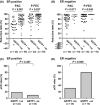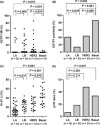GSTP1 expression predicts poor pathological complete response to neoadjuvant chemotherapy in ER-negative breast cancer
- PMID: 22320227
- PMCID: PMC7659189
- DOI: 10.1111/j.1349-7006.2012.02231.x
GSTP1 expression predicts poor pathological complete response to neoadjuvant chemotherapy in ER-negative breast cancer
Abstract
The purpose of the present study was to investigate the association of glutathione S-transferase P1 (GSTP1) expression with resistance to neoadjuvant paclitaxel followed by 5-fluorouracil/epirubicin/cyclophosphamide (P-FEC) in human breast cancers. The relationship of GSTP1 expression and GSTP1 promoter hypermethylation with intrinsic subtypes was also investigated. In this study, primary breast cancer patients (n = 123, stage II-III) treated with neoadjuvant P-FEC were analyzed. Tumor samples were obtained by vacuum-assisted core biopsy before P-FEC. GSTP1 expression was determined using immunohistochemistry, GSTP1 promoter methylation index (MI) using bisulfite methylation assay and intrinsic subtypes using DNA microarray. The pathological complete response (pCR) rate was significantly higher in GSTP1-negative tumors (80.0%) than GSTP1-positive tumors (30.6%) (P = 0.009) among estrogen receptor (ER)-negative tumors but not among ER-positive tumors (P = 0.267). Multivariate analysis showed that GSTP1 was the only predictive factor for pCR (P = 0.013) among ER-negative tumors. Luminal A, luminal B and HER2-enriched tumors showed a significantly lower GSTP1 positivity than basal-like tumors (P = 0.002, P < 0.001 and P = 0.009, respectively), while luminal A, luminal B and HER2-enriched tumors showed a higher GSTP1 MI than basal-like tumors (P = 0.076, P < 0.001 and P < 0.001, respectively). In conclusion, these results suggest the possibility that GSTP1 expression can predict pathological response to P-FEC in ER-negative tumors but not in ER-positive tumors. Additionally, GSTP1 promoter hypermethylation might be implicated more importantly in the pathogenesis of luminal A, luminal B and HER2-enriched tumors than basal-like tumors.
© 2012 Japanese Cancer Association.
Figures




Similar articles
-
Association of GSTP1 methylation with aggressive phenotype in ER-positive breast cancer.Anticancer Res. 2013 Dec;33(12):5617-23. Anticancer Res. 2013. PMID: 24324107
-
14-3-3σ expression is associated with poor pathological complete response to neoadjuvant chemotherapy in human breast cancers.Breast Cancer Res Treat. 2012 Jul;134(1):229-36. doi: 10.1007/s10549-012-1976-x. Breast Cancer Res Treat. 2012. PMID: 22315133
-
Neoadjuvant everolimus plus letrozole versus fluorouracil, epirubicin and cyclophosphamide for ER-positive, HER2-negative breast cancer: study protocol for a randomized pilot trial.Trials. 2017 Oct 25;18(1):497. doi: 10.1186/s13063-017-2228-5. Trials. 2017. PMID: 29070044 Free PMC article. Clinical Trial.
-
Differential response of immunohistochemically defined breast cancer subtypes to anthracycline-based adjuvant chemotherapy with or without paclitaxel.PLoS One. 2012;7(6):e37946. doi: 10.1371/journal.pone.0037946. Epub 2012 Jun 5. PLoS One. 2012. PMID: 22679488 Free PMC article.
-
Current strategy for triple-negative breast cancer: appropriate combination of surgery, radiation, and chemotherapy.Breast Cancer. 2011 Jul;18(3):165-73. doi: 10.1007/s12282-011-0254-9. Epub 2011 Feb 3. Breast Cancer. 2011. PMID: 21290263 Review.
Cited by
-
The history of small extracellular vesicles and their implication in cancer drug resistance.Front Oncol. 2022 Aug 24;12:948843. doi: 10.3389/fonc.2022.948843. eCollection 2022. Front Oncol. 2022. PMID: 36091133 Free PMC article. Review.
-
Upregulation of Long Non-Coding RNA DRAIC Correlates with Adverse Features of Breast Cancer.Noncoding RNA. 2018 Dec 11;4(4):39. doi: 10.3390/ncrna4040039. Noncoding RNA. 2018. PMID: 30544991 Free PMC article.
-
An integral genomic signature approach for tailored cancer therapy using genome-wide sequencing data.Nat Commun. 2022 May 26;13(1):2936. doi: 10.1038/s41467-022-30449-7. Nat Commun. 2022. PMID: 35618721 Free PMC article.
-
Single drug biomarker prediction for ER- breast cancer outcome from chemotherapy.Endocr Relat Cancer. 2018 Jun;25(6):595-605. doi: 10.1530/ERC-17-0495. Epub 2018 Mar 29. Endocr Relat Cancer. 2018. PMID: 29599124 Free PMC article.
-
Research progress and applications of epigenetic biomarkers in cancer.Front Pharmacol. 2024 Apr 12;15:1308309. doi: 10.3389/fphar.2024.1308309. eCollection 2024. Front Pharmacol. 2024. PMID: 38681199 Free PMC article. Review.
References
-
- Kuerer HM, Newman LA, Smith TL et al Clinical course of breast cancer patients with complete pathologic primary tumor and axillary lymph node response to doxorubicin‐based neoadjuvant chemotherapy. J Clin Oncol 1999; 17: 460–9. - PubMed
-
- Bear HD, Anderson S, Smith RE et al Sequential preoperative or postoperative docetaxel added to preoperative doxorubicin plus cyclophosphamide for operable breast cancer: National Surgical Adjuvant Breast and Bowel Project Protocol B‐27. J Clin Oncol 2006; 24: 2019–27. - PubMed
-
- Liedtke C, Mazouni C, Hess KR et al Response to neoadjuvant therapy and long‐term survival in patients with triple‐negative breast cancer. J Clin Oncol 2008; 26: 1275–81. - PubMed
-
- Sachelarie I, Grossbard ML, Chadha M, Feldman S, Ghesani M, Blum RH. Primary systemic therapy of breast cancer. Oncologist 2006; 11: 574–89. - PubMed
-
- Kaufmann M, von Minckwitz G, Bear HD et al Recommendations from an international expert panel on the use of neoadjuvant (primary) systemic treatment of operable breast cancer: new perspectives 2006. Ann Oncol 2007; 18: 1927–34. - PubMed
Publication types
MeSH terms
Substances
Supplementary concepts
LinkOut - more resources
Full Text Sources
Other Literature Sources
Medical
Molecular Biology Databases
Research Materials
Miscellaneous

